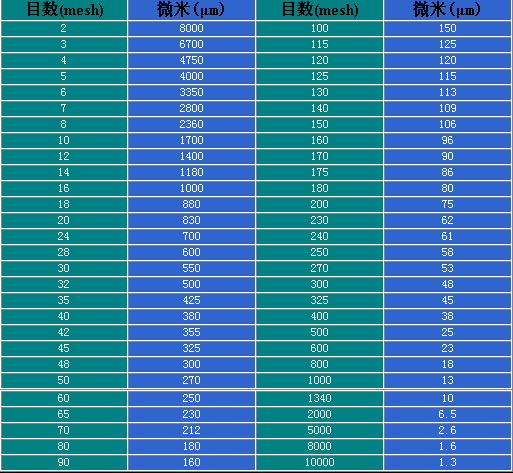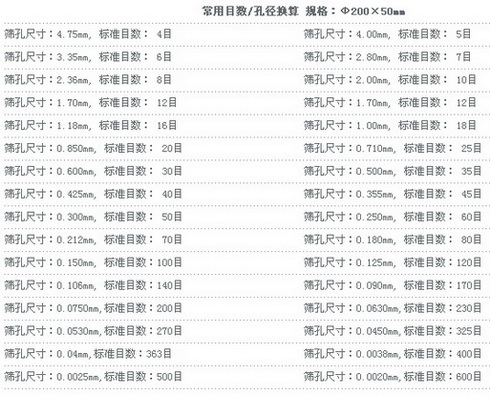Universal crusher screen mesh comparison table
The number of holes is the number of holes, which is the number of holes per square inch. The larger the mesh size, the smaller the aperture. In general, the number of meshes × aperture (microns) = 15,000.
For example, the 400 mesh screen has a pore size of about 38 microns; the 500 mesh screen has a pore size of about 30 microns. Due to the problem of open cell rate, which is because of the difference in the thickness of the wire used in the weaving of the net, the standards of different countries are different. There are currently three types of American standards, British standards and Japanese standards, of which the United Kingdom and the United States are similar. Japan has a big difference. China uses American standards, which can be calculated using the formula given above.
The size of the mesh determines the size of the mesh aperture, and the size of the mesh aperture determines the large particle Dmax of the sieved powder. Therefore, we can see that the 400-mesh polishing powder is completely fine, such as only 1-2 microns, and it is entirely possible to be 10 microns, 20 microns. Because the mesh has a pore size of about 38 microns. Our D50 for 400 mesh polishing powders is 20 microns.




────────────────────
Mesh|Mesh definition|Grain size|Aperture comparison table
Standard mesh number:
1. The term refers to the number of empty eyes per square inch of screen. 50 mesh means that the number of holes per square inch is 50, and 500 is 500. The higher the mesh, the more holes. In addition to the hole indicating the screen, it is also used to indicate the particle size of the particles that can pass through the screen. The higher the mesh size, the smaller the particle size, and the standard sieve needs to be accurately measured with a standard vibrating screen.
2. The particle size of the powder is called the particle size. Due to the complexity of the particle shape, there are usually several representation methods such as sieve size, sedimentation particle size, equivalent volume particle size, and equivalent surface area particle size. The sieve size is the size of the sieve through which the particles can pass through the screen, and is expressed as the number of sieve holes in the screen of 1 inch (25.4 mm) width, and is therefore referred to as "mesh". At present, there is no uniform technical standard for powder particle size at home and abroad, and each enterprise has its own definition and representation method of particle size index. Screen specifications in different countries and different industries have different standards, so the meaning of “mesh†is difficult to unify. At present, the calculated diameter of the equivalent volume particles is used internationally to represent the particle size. Expressed in μm or mm
Standard mesh number | particle size comparison table:

────────────────────
What is the unit? How to convert between micro and micro
Explanation (1)
Sieve inner diameter (μm) ≈ 14832.4 / sieve mesh
The unit of measure particle size refers to the size of the raw material particles, and is generally expressed in terms of the large length of the particles. The mesh is the size of the mesh size indicating the standard sieve. In the Taylor standard sieve, the so-called mesh is the number of sieve holes in the length of 2.54 cm (1 inch), and is simply referred to as the mesh.
Taylor standard screen: Taylor's screen index is based on a 200 mesh screen size of 0.074 mm, multiplied or divided by the square root of the main modulus (1.141) n (f = 1, 2, 3...) , the size of the mesh is 200 or less. If the square root of the number 2 (1.1892) is multiplied or divided by 0.074 mm, a series of mesh sizes with finer indexing can be obtained.
The larger the mesh number, the finer the particles. Similar to the magnification of the metallographic structure.
Adding a positive or negative sign before the number of meshes indicates whether the mesh of the mesh can be missed. A negative number indicates a mesh that can leak through the mesh, that is, the particle size is smaller than the mesh size; and a positive number indicates a mesh that cannot leak through the mesh, that is, the particle size is larger than the mesh size.
For example, the particles are -100 mesh to +200 mesh, which means that the particles can leak from the mesh of 100 mesh and cannot leak from the mesh of 200 mesh. When screening the particles of this mesh, the mesh should be large ( 200) is placed under the screen with a small mesh size (100), and the particles of -100 to 200 mesh are left in the mesh having a large mesh size (200).

(The data is the same as the * group)
The number of holes is the number of holes, which is the number of holes per square inch. The larger the mesh size, the smaller the aperture. In general, the number of meshes × aperture (microns) = 15,000. For example, a 400 mesh screen has a pore size of about 38 microns; a 500 mesh screen has a pore size of about 30 microns. Due to the problem of open cell rate, which is because of the difference in the thickness of the wire used in the weaving of the net, the standards of different countries are different. There are currently three types of American standards, British standards and Japanese standards, of which the United Kingdom and the United States are similar. Japan has a big difference. China uses American standards, which can be calculated using the formula given above.
It can be seen from this definition that the size of the mesh determines the size of the mesh aperture. The size of the sieve pore size determines the large particle Dmax of the sieved powder. Therefore, we can see that the 400-mesh polishing powder is completely fine, such as only 1-2 microns, and it is entirely possible to be 10 microns, 20 microns. Because the mesh has a pore size of about 38 microns. Our D50 for 400 mesh polishing powders is 20 microns. The photo of the polishing powder is given in the drawing, and the scale is 50 microns.
Therefore, it is not appropriate to use the mesh to constant the particle size of the polishing powder. The correct method should be to use the particle size (D10, median diameter D50, D90) to indicate the particle size, and to calculate the large particle size of the zui. If you have seen the standard JIS standard for abrasives in Japan, you will feel very scientific. Each of their abrasives gives the requirements of D3, D50, and D97, and the data is different when using different principles of the particle size analyzer. The requirements are very strict. For example, D50 is a 2 micron powder, D3 is approximately 0.9 microns, and D97 is 4 microns. What does that mean? Known as a 2 micron powder, it should not exceed 3% less than 0.9 microns, and should not exceed 3% above 4 microns. This is very strict, and most of the polishing powders (including foreign ones) seen on the market cannot meet this requirement, especially if the fine powder exceeds the standard.
There is a reason for characterizing the particle size of the polishing powder by mesh. The old polishing powder mill uses dry ball milling and dry sieving, so the D50 of the 300-mesh powder is about 9 microns, and the 500-mesh is that the D50 is about 2 microns. Everyone has been using this way, and it can basically guide production and use. However, with the advent of new production processes and the need for higher precision polishing requirements, this approach should also be improved.
Explanation (2)
1. The term refers to the number of empty eyes per square inch of screen. 50 mesh means that there are 50 holes per square inch, and 500 holes are 500. The higher the mesh, the more holes. In addition to the apertures representing the screen, it is also used to indicate the particle size of the particles that can pass through the screen. The higher the mesh size, the smaller the particle size.
2. Powder particle size is called particle size. Due to the complexity of the particle shape, there are usually several representation methods such as sieve size, sedimentation particle size, equivalent volume particle size, and equivalent surface area particle size. The sieve size is the size of the sieve through which the particles can pass through the screen, and is expressed as the number of sieve holes in the screen of 1 inch (25.4 mm) width, and is therefore referred to as "mesh". At present, there is no uniform technical standard for powder particle size at home and abroad, and each enterprise has its own definition and representation method of particle size index. Screen specifications in different countries and different industries have different standards, so the meaning of “mesh†is difficult to unify.
────────────────────
Attachment: Conversion relationship: 1 μm = 1 micrometres (micron) = 0.001 millimetre (mm)
The empirical formula for the conversion of micron and mesh is as follows. The larger the mesh, the larger the error.

Squid Rings Raw,Frozen squid rings,This year's Squid Rings
ZHOUSHAN GENHO FOOD CO.,LTD , https://www.genho-food.com